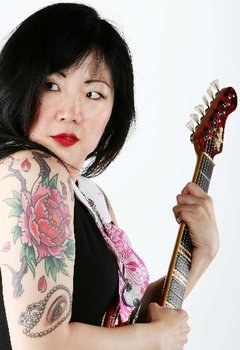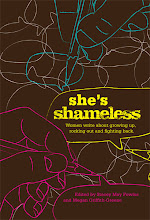 Tonight I watched the premier of a new reality dating show on FOX TV that is reminiscent of “The Bachelor” only plus-size. Yep, the whole premise is that an overweight guy chooses among 15 plus size women by going on dates and on the finale of the show asks one them to be his wife. The name of this program is “More to Love.” Because there is more cushion for the pushing, get it? That just irks me to no end.
Tonight I watched the premier of a new reality dating show on FOX TV that is reminiscent of “The Bachelor” only plus-size. Yep, the whole premise is that an overweight guy chooses among 15 plus size women by going on dates and on the finale of the show asks one them to be his wife. The name of this program is “More to Love.” Because there is more cushion for the pushing, get it? That just irks me to no end.Luke is a 26-year-old real estate developer who owns his own firm and wants to find a woman to settle down with. He is a heftier guy and professes, “I’ve gotten my heart broken because of my size.” Luke happens to like larger women and claims that he wants to get to know the women he is dating for who they really are, not based on their appearance.
 Now I support the idea of curvier more voluptuous women being featured in mainstream television as being able capable of experiencing romance and being accepted for their personalities but something doesn't smell right. It’s the fact that this show revolves around a heftier man who is attracted to large women and that is the sole reason they were chosen. In other words, you’re not going to see a size 14 bachelorette or contestant on the “The Bachelor” any time soon, which is a shame.
Now I support the idea of curvier more voluptuous women being featured in mainstream television as being able capable of experiencing romance and being accepted for their personalities but something doesn't smell right. It’s the fact that this show revolves around a heftier man who is attracted to large women and that is the sole reason they were chosen. In other words, you’re not going to see a size 14 bachelorette or contestant on the “The Bachelor” any time soon, which is a shame.My question is, why do plus size women have to fit into their own category of television? Why are they excluded from romance in the media unless it is specified that these are “big, big” women that you are watching, got it? Not thin, but fat, and not with a ph. Apparently its not possible for men to love or be attracted to anyone who isn’t stereotypically skinny, so a curvy woman’s only hope is a reality television dating show where the bachelor is down with love handles.
As I watched the opening explanation of the premise I could almost hear a silent voiceover spewing out “these women aren’t normal and they only way they can get with this bachelor is because he has a thing for fat women.” Although it is positive to see these women in the mainstream its demeaning that there is only one reason for their exposure, almost like a freak show where audiences can come to gawp and gape at the large women who are all fighting for the only man who will have them.
 It’s sad that in our society women who don’t fulfill the mainstream look of thin or petite require their own section in the clothing aisle, or are only featured in fetish porn because they aren’t seen as “normal” by the media’s standards. That’s why they have their own show, where they are corralled like cattle as their own “special need” brand of woman.
It’s sad that in our society women who don’t fulfill the mainstream look of thin or petite require their own section in the clothing aisle, or are only featured in fetish porn because they aren’t seen as “normal” by the media’s standards. That’s why they have their own show, where they are corralled like cattle as their own “special need” brand of woman.This is further established in the way these women are portrayed as they talk one-on-one with the viewers about their feelings. Along the bottom portion of the screen we see their name, city, vocation, age, height and weight. You heard me, weight. Are you freaking kidding me? First let’s put these women in the spotlight as “big” women and then let’s weigh them like farm animals, because if the premise is that a man could love them for who they are, not their size, constantly highlighting their weight really reinforces that.
What other dating show focuses in on the weight of the men or women? None, because this is a show about “fat” people, so obviously the audience needs to know how much they weigh to further ostracize them as these disgusting, pathetic creatures that we should be thankful we are not.
We even see the weight of Luke the bachelor, at 330 lbs. because remember folks, this show has already established that he isn’t normal either, because if he was slimmer he wouldn’t be on a show that showcases his love for large women. But one thing to note from a quick preview of the first episode is that this guy’s attitude towards women seems pretty admirable. He wants to get to know the personalities of these ladies and says that looks aren’t a factor for him. Whether that is actually true remains to be seen, but what I immediately wondered when I saw his weight emphasized was why the typical, muscular bachelor type couldn’t be interested in curvier women?
 Would that be too strange and freaky for mainstream viewers? A stereotypically, toned, attractive guy and a girl who isn’t the size of a twig dating each other? I guess we can’t go around showing audiences that larger women can be seen as attractive to EVERYONE, because that would actually make them think that they are attractive! Then the media wouldn’t be able to keep stuffing *oops I mean selling* every Jenny Craig, Weight Watchers, acai berry, diet pill, or lipo treatment down their throats.
Would that be too strange and freaky for mainstream viewers? A stereotypically, toned, attractive guy and a girl who isn’t the size of a twig dating each other? I guess we can’t go around showing audiences that larger women can be seen as attractive to EVERYONE, because that would actually make them think that they are attractive! Then the media wouldn’t be able to keep stuffing *oops I mean selling* every Jenny Craig, Weight Watchers, acai berry, diet pill, or lipo treatment down their throats.Some of these women seem to love themselves and their bodies, for example, a blonde woman named Michelle says, “I don’t wake up everyday and say I’m going to diet and get skinnier. No I’m going to buy the clothes that fit me today and live for today” while another says “I’m ready to prove to everybody that love doesn’t have a shape or a size.”
 But then there are others who suffer from a terrible lack of self esteem and have undergone a lot of judgement and pressure from the men in their past due to their size. One woman made a very sad confession that when she meets guys for the first time she still thinks, “I’m probably too fat for him. He’d probably like one of my skinny friends.”
But then there are others who suffer from a terrible lack of self esteem and have undergone a lot of judgement and pressure from the men in their past due to their size. One woman made a very sad confession that when she meets guys for the first time she still thinks, “I’m probably too fat for him. He’d probably like one of my skinny friends.”There definitely are a some opportunities for “More to Love” to break down the stereotypes of romance and body image, but I still squirm at the thought that today the media still has to package it as a show of “fat” women pursuing love, like a warning label or a “this program may not be suitable for younger audiences” pre-show message. Taking the value of reality television, or the lack thereof out of this conversation, what I would really like to see are women of all shapes and sizes represented as people of worth who have real beauty in the media. If shows like “More to Love” are a positive step then we still have a long way to go.

 The image of a man is painted on the trunk of a tree. Its limbs rise above the man’s head and hold a small house perched atop its branches. The tree stands inside the Royal Ontario Museum (ROM). Behind the tree, tiny 3D shacks are painted on clouds of orange smoke that extend up onto the wall.
The image of a man is painted on the trunk of a tree. Its limbs rise above the man’s head and hold a small house perched atop its branches. The tree stands inside the Royal Ontario Museum (ROM). Behind the tree, tiny 3D shacks are painted on clouds of orange smoke that extend up onto the wall. The “Hug me tree” stood on Queen Street West until it was knocked down by a car. Neighbourhood residents rescued the tree from being tossed into the trash.
The “Hug me tree” stood on Queen Street West until it was knocked down by a car. Neighbourhood residents rescued the tree from being tossed into the trash.  Tent City became home for an entire homeless population that began growing on an empty lot at the base of Parliament Street as early as 1996. For many, the shantytown represented an act of solidarity and civil disobedience, as residents utilized society’s garbage to construct an independent way of life—until they were evicted in September 2002.
Tent City became home for an entire homeless population that began growing on an empty lot at the base of Parliament Street as early as 1996. For many, the shantytown represented an act of solidarity and civil disobedience, as residents utilized society’s garbage to construct an independent way of life—until they were evicted in September 2002. On the packed gravel where up to 200 people lived an alternatively housed existence, he invited
On the packed gravel where up to 200 people lived an alternatively housed existence, he invited  While painting on the site, Toronto artist
While painting on the site, Toronto artist  She was inspired by Gustav Klimt’s painting “Hope II” at the Museum of Modern Art in New York and wanted to capture the unity of that feminine family. A pregnant woman was sprayed on the roof of the tall house that she painted. The woman’s head was bent down, breasts bare, a golden mosaic of patterned cloth hanging down over her stomach and onto the wall. The other walls were filled with the images of three women draped over one another, eyes closed, hands raised in prayer.
She was inspired by Gustav Klimt’s painting “Hope II” at the Museum of Modern Art in New York and wanted to capture the unity of that feminine family. A pregnant woman was sprayed on the roof of the tall house that she painted. The woman’s head was bent down, breasts bare, a golden mosaic of patterned cloth hanging down over her stomach and onto the wall. The other walls were filled with the images of three women draped over one another, eyes closed, hands raised in prayer.  When the ROM invited Ostrom to bring the street art into the gallery setting, he wanted the show to retain some of the fluid spontaneity that is part of graffiti culture.
When the ROM invited Ostrom to bring the street art into the gallery setting, he wanted the show to retain some of the fluid spontaneity that is part of graffiti culture.  Accessibility was the biggest drawback of exhibiting in the ROM for those who couldn’t afford the $22 admission fee. Ostrom tried to address this issue by giving free tours to different youth and homeless groups, as well as advertising free visitor nights. He also wanted to address the larger themes of homelessness and street art by using Housepaint as a platform for the voices of activists, artists and city councillors.
Accessibility was the biggest drawback of exhibiting in the ROM for those who couldn’t afford the $22 admission fee. Ostrom tried to address this issue by giving free tours to different youth and homeless groups, as well as advertising free visitor nights. He also wanted to address the larger themes of homelessness and street art by using Housepaint as a platform for the voices of activists, artists and city councillors.  He began filming when there were only six houses on the lot, as members of the community struggled with addictions, scavenged and built shelters, cooked together and shared their lives with him on camera.“The only difference between Tent City and a small little neighbourhood is they don’t have driveways and garages. They weren’t borrowing their friend’s boat or their friend’s driver to go to the golf course but they would borrow his hammer or they would borrow cigarettes,” said Weissman.
He began filming when there were only six houses on the lot, as members of the community struggled with addictions, scavenged and built shelters, cooked together and shared their lives with him on camera.“The only difference between Tent City and a small little neighbourhood is they don’t have driveways and garages. They weren’t borrowing their friend’s boat or their friend’s driver to go to the golf course but they would borrow his hammer or they would borrow cigarettes,” said Weissman.  According to Cathy Crowe, co-founder of the Toronto Disaster Relief Committee (TDRC), the silver lining in the death of Tent City was the launch of rent supplements for 105 of the former residents to obtain housing, a program which has been implemented in various provinces. The street nurse who once worked in Tent City deemed this solution a band-aid measure until the federal government funds a national affordable housing program.
According to Cathy Crowe, co-founder of the Toronto Disaster Relief Committee (TDRC), the silver lining in the death of Tent City was the launch of rent supplements for 105 of the former residents to obtain housing, a program which has been implemented in various provinces. The street nurse who once worked in Tent City deemed this solution a band-aid measure until the federal government funds a national affordable housing program. Housepaint canvas houses will be
Housepaint canvas houses will be 
 *published in the July issue of the
*published in the July issue of the 
 Sexy Mark Brown
Sexy Mark Brown You will also be able to learn the tricks of the trade at Canada’s only Burlesque University, where the seasoned veterans of erotic undressing will teach workshops on everything from fan dancing and persona development to the art of shimmying.
You will also be able to learn the tricks of the trade at Canada’s only Burlesque University, where the seasoned veterans of erotic undressing will teach workshops on everything from fan dancing and persona development to the art of shimmying. With so many hot little numbers coming to the city you better believe that lots of delicious candy will be unwrapped on stage. Because there's nothing sexier than a woman in control of her own fierce, voluptious, natural beauty, and she knows it too.
With so many hot little numbers coming to the city you better believe that lots of delicious candy will be unwrapped on stage. Because there's nothing sexier than a woman in control of her own fierce, voluptious, natural beauty, and she knows it too.












 So who do they want us to purchase this happy-rainbow-and-sunshine-pussy-in-a-package for? Do you really feel the need to pay to smell like floral bouquet down there? If we were meant to smell that way then we would have been born that way. So what message are we really getting from advertisers? My ears perked up at this line, “After intimacy, refresh.”
So who do they want us to purchase this happy-rainbow-and-sunshine-pussy-in-a-package for? Do you really feel the need to pay to smell like floral bouquet down there? If we were meant to smell that way then we would have been born that way. So what message are we really getting from advertisers? My ears perked up at this line, “After intimacy, refresh.” What pisses me off is the implied message that that our vaginas, which are the source of all human life by the way (in case you forgot), have to meet a certain standard to fit into this impossible definition of “femininity.” Like if you visit the tea party without matching gloves and doilies your fucked. Our face, breasts, legs, stomach, complexion, hair and our pussies are subjected to enough panhandling in our lifetimes to make you want to riot. Frankly I think I’d like to. My sign would read, “Quit plaguing my body! Let my pussy go!”
What pisses me off is the implied message that that our vaginas, which are the source of all human life by the way (in case you forgot), have to meet a certain standard to fit into this impossible definition of “femininity.” Like if you visit the tea party without matching gloves and doilies your fucked. Our face, breasts, legs, stomach, complexion, hair and our pussies are subjected to enough panhandling in our lifetimes to make you want to riot. Frankly I think I’d like to. My sign would read, “Quit plaguing my body! Let my pussy go!”






















